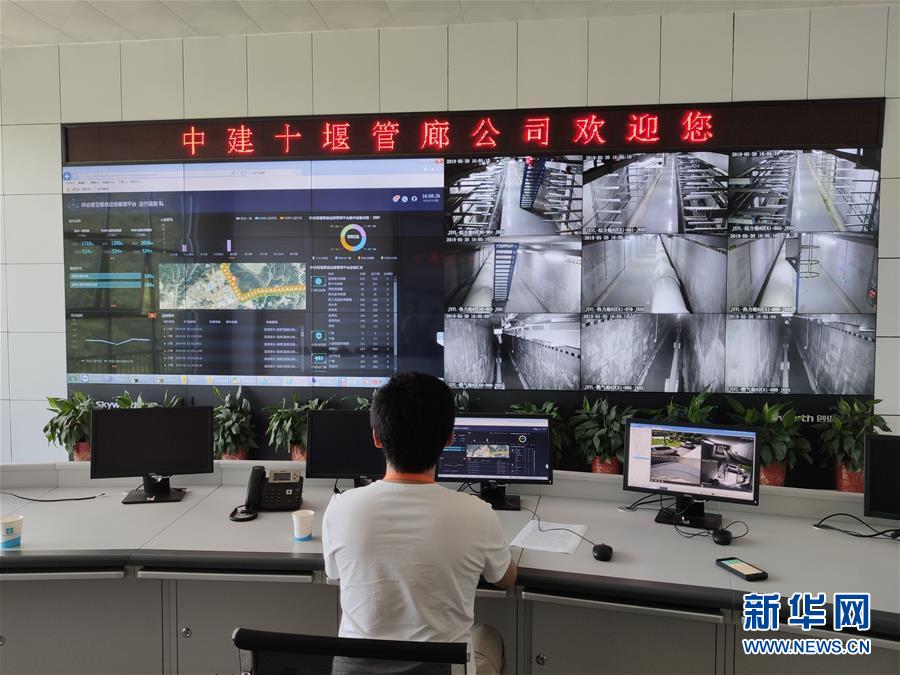
Maintenance workers of utility tunnels carry out inspections via intelligent operation and the maintenance platform in Shiyan on May 30, 2019. [Photo/Xinhua]
By adopting multiple sewage disposal methods and closing down a number of heavily polluting companies, Shiyan, a city in central China's Hubei province and a key water source for the central route of the South-to-North Water Diversion Project, is demonstrating its determination to pursue a green path of development.
In recent years, as a national pilot city for promoting ecological achievements, Shiyan's local government has been seeking green transformation of its industries and ecological progress in its economic and social development.
Excel in sewage disposal
At a water purification plant in Shiyan, a constructed rapid infiltration (CRI) tank was spouting water during the aeration operation.
"The sewage-treating tanks serve as the doorkeepers of Sihe River," said Zhou Qingrong, Party secretary of the city's Maojian district. According to Zhou, advanced sewage disposal methods used at facilities in the downstream of the river allow a daily processing capacity of 60,000 tons. After treatment, the water could reach drinkable quality standard, and flows into the Danjiangkou Reservoir, a water source for the central route of the South-to-North Water Diversion Project.
In recent years, the local government made many moves to reduce water pollution, including cleaning up 590 sewage outlets, desilting 138-kilometer watercourse, and setting up over 1,400 kilometers of pipelines for sewage treatment. The city currently applies 26 types of sewage treatment techniques-out of 30 available in the world.
According to Feng Anlong, head of Shiyan's ecology and environment bureau, five rivers in the city previously failed to meet its water quality standards. However, the efforts since to clean up those rivers using the new treatment methods and facilities have received nationwide praise.
Closing down polluting companies
On top of building new water treatment facilities, Shiyan also had to make sacrifices to its local economy in order to bring clean drinking water back in its Danjiangkou Reservoir.
The city previously produced 43% of China's yellow ginger. It had 79 yellow ginger processing companies, which employed 1 million people and totaled an annual output worth 1.4 billion yuan (US$203.44 million).
However, processing yellow ginger produces a large amount of wastewater. Therefore, the whole industry was uprooted from the city.
According to reports, the city shut down nearly 500 heavily polluting companies, rejected 145 projects that failed to comply with environmental protection policies, and removed 168,000 breeding cages around the reservoir.
Now, seven kinds of pipelines, including the sewage pipelines, are installed in utility tunnels under the city, and the maintenance workers can carry out inspections via an intelligent operation and maintenance platform.
Shiyan is one of the first 10 pilot cities that constructed such utility tunnels. The city has built 53.3 kilometers of the tunnels underground.
Benefitting the people
At present, the clear water and the healthy ecology overall are releasing ecological dividends and benefiting the people in Shiyan.
The city attracted many bottled water companies, including the popular brand Nongfu Spring. VOSS, another bottled water company in the city's Zhuxi county, even exports overseas.
The efforts of the city in developing ecologically friendly industries also helped to lift the poor people out of poverty.
Shengshui village, in Shiyan's Desheng town, is a thriving tea farming community. Town chief Wang Jinwu said, the city's green development is helping to lift the burden of surrounding towns and townships in selling fresh tea leaves, and effectively increasing the income of tea gardens.
Zhang Weiguo, Shiyan's Party secretary, said the city is vigorously developing ecological and cultural tourism, green and organic agricultural product processing, biomedicine, energy conservation and environment protection, new energy and new materials, and other modern industries, in a bid to tap the city's ecological potential and transform its ecological resources into economic growth. With these moves, the old industrial city is marching on a green path.